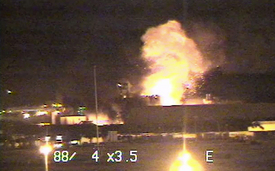
An independent federal board says a series of explosions triggered by combustible dust in confined spaces caused the fatal Imperial Sugar refinery disaster near Savannah, Ga., that killed 14 workers and injured 36 last year.
In a report released Sept. 24, the Chemical Safety Board blames the company for the February 2008 disaster, which leveled the factory. It also says the then Bush-controlled Occupational Safety and Health Administration (OSHA) fell down on the job by not imposing standards on factories to control combustible dust.
The CSB held a public meeting Sept. 24 near the refinery site in Fort Wentworth to discuss the new report.
Under President Obama’s new acting OSHA administrator, former union job safety and health specialist Jordan Barab, the agency has started working on comprehensive combustible dust standards.
Union health and safety specialists welcomed the report on the Imperial Sugar blast and its recommendations for comprehensive and strong OSHA combustible dust standards that companies must meet. The unions, however, want immediate and forceful action.
Evan Yeats, a spokesperson for the United Food and Commercial Workers, charged that, given its findings, the CSB is failing workers by not calling for “immediate, emergency changes in OSHA procedures to protect workers.”
Rep. John Barrow, D-Ga., who represents Fort Wentworth, backed up the union, saying, “This report makes clear why we need an immediate temporary standard to prevent tragedies like the one we had at Imperial Sugar. I commend the Department of Labor for the steps they’ve taken to get permanent rules governing combustible dust on the books, but the hard reality is that it could be years before those regulations are in place.”
Barrow has introduced a bill that would require an immediate temporary standard until a permanent one is devised.
CSB Chairman John Bresland spoke at the public meeting about his anger at the Bush administration’s lack of action after many complaints by his board over the years. He said, “Perhaps a bill is the way to go. It’s never been tested.” In the past, he said, companies have been able to successfully challenge in court many temporary OSHA regulations.
The disaster at Imperial Sugar was part of a much larger national problem. The CSB report notes that previous investigations it conducted showed that from 1980-2005 there were at least 281 combustible dust fires and explosions that caused at least 118 workers to die and more than 700 others to suffer injury, not to mention extensive damage to industrial facilities.
The CSB says it actually went to OSHA in November 2006, 15 months before the Imperial Sugar tragedy, in an attempt to get the government to develop a comprehensive regulatory standard for combustible dust.
The Bush administration did nothing, however, until the explosions and deaths in Georgia. Then it sent letters to factories saying it would check for dust hazards.
The CSB report says the Imperial Sugar disaster was actually a series of blasts “from ongoing releases of sugar from inadequately designed and maintained dust collection equipment, conveyors and sugar handling equipment.
“Inadequate housekeeping practices allowed highly combustible sugar dust and granulated sugar to build up throughout the refinery’s packing buildings,” the report says.
CSB probers say the first explosion was inside a sugar conveyor located beneath two large storage silos. Shortly before the explosion, the company had enclosed the conveyor with steel panels, “creating a confined, unventilated space where sugar dust could accumulate to an explosive concentration.
“Sugar dust inside the enclosed conveyor was likely ignited by an overheated bearing, causing an explosion that traveled into the adjacent packing buildings, dislodging sugar dust accumulations and spilled sugar located on equipment, floors and other horizontal services.
“The result was a powerful cascade of secondary dust explosions that fatally injured 14 workers and injured 36 others, many with life-threatening burns. The refinery’s packing buildings were largely destroyed by the blasts and ensuing fires.”
In a telephone interview, CSB’s investigative supervisor, John Vorderbrueggen, an engineer, blamed the company.
“Imperial’s management, as well as managers at Wentworth, did not take effective actions over many years to control dust explosion hazards – even as smaller fires and explosions continued at their plants and at other sugar facilities around the country,” he said.
The CSB report notes that sugar refineries have known about the combustible dust hazard since 1925, if not before. Fort Wentworth managers “started getting concerned about dust conditions there 42 years ago,” the report says.
Ten workers died in two sugar dust explosions at the plant in the 1960s, but the company did nothing.
Before the latest explosions, workers testified, spilled sugar was knee-deep in places on the floor and sugar dust had coated equipment and other elevated surfaces.
Ignoring the buildup of combustible dust and sugar is not the only thing Imperial’s management was guilty of, according to the CSB report.
There had been no evacuation drills for workers and there was no properly functioning emergency lighting system in place. Both of these problems “made it difficult for workers to escape from the labyrinth of explosion-damaged buildings as the fires continued to spread,” the report says.
Company managers and public relations personnel have not returned calls for comments.
The union is saying that, while it agrees with the CSB report, it has many concerns.
Yeats, who represented the union at the Sept. 24 community meeting, got up and said, “You realize this is all just a public relations event, right?” He was particularly angry about parts of the report that called for trade associations of various manufacturers to monitor themselves.
“It represents no protection for workers,” Yeats said. “Since their last report last December, we have called on the CSB to insist that OSHA implement immediate, temporary measures to address this. They did not. The process of changing OSHA regulations takes years.”
The CSB is an independent federal agency responsible for investigating industrial chemical accidents. The board members are appointed by the president and confirmed by the Senate. CSB investigators are charged with examining all aspects of chemical accidents, including physical causes such as equipment failure as well as inadequacies in safety regulations, codes, standards, management systems, training and industry practices. While the board cannot issue fines, it makes safety recommendations to plants, industry groups, labor groups and regulatory bodies such as OSHA and the Environmental Protection Administration.
jwojcik@pww.org










